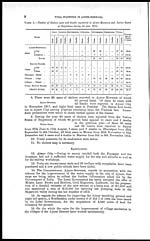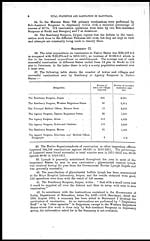Medicine - Vaccination > 1909-1927 - Report on sanitation, dispensaries, and jails in Rajputana > Report on sanitation, dispensaries, and jails in Rajputana for 1911, and on vaccination for the year 1911-1912 > Report on sanitation, dispensaries, and jails in Rajputana for 1911, and on vaccination for the year 1911-1912
(9) Page 3
Download files
Individual page:
Thumbnail gallery: Grid view | List view

VITAL STATISTICS IN NATIVE STATES, 3
NATIVE STATES.
17. Jaipur.—The light railway continues to perform valuable work for all
conservancy purposes. Rubbish and city sweepings are burnt in incinerators.
18. Jaipur has an excellent drinking water supply obtained from a series
of wells in the river bed and distributed through pipes to most parts of the city ;
there is also a good well water supply which is carefully supervised.
19. Jodhpur.—The water supply throughout the year was good. Tanks
and wells in Jodhpur were not filled during the year owing to defective rains.
20. The sanitation is in the hands of the Municipal Committee.
21. Bikaner.—Sanitation in Bikaner city is supervised by the Municipal
Committee.
22. Bharatpur.—A tramway has been nearly completed to carry all
excreta, rubbish and sewage water to the trenching ground, some miles away to
the west of the city.
23. Corrugated iron rubbish bins have been placed throughout the city, as
well as a number of masonry urinals.
24. It is proposed-to provide galvanised iron latrines with Bailey's
patent moveable seats for the Bharatpur city, some have been supplied during
the year and the remainder will be provided in the following year.
25. Kotah.—The sanitation of Kotah city is making general progress.
(1) Some of the streets have been paved and drained.
(2) A number of broken down houses have been removed.
(3) The slaughter house has been improved and stone slabs provided for
chopping meat.
26. The local sanitary committee at Baran, Sangod, Khanpur, Iklera,
Manohar Thana and Bakani have worked very smoothly.
VACCINATION.
STATEMENT I.
27. In Ajmer-Merwara the number of primary vaccinations rose from
13,100 in 1910-1911 to 15,486 in 1911-1912 and re-vaccination from 306 in
1910-1911 to 1,034 in 1911-1912, this increase is mainly due to the small-pox
epidemic in the district.
28. The number of vaccinators was 15 and one Native Superintendent,
the same as in the previous year, each vaccinator performed an average of
1,108 against 881 vaccinations in 1910-1911 and the cost of each successful case
was 38 pies against 47 pies in the previous season.
29. The Civil Surgeon, Ajmer, inspected 506 children against 670 in
1910-1911, all of whom were found successful and the Superintendent at
Nasirabad examined 1,411 children against 553 in the previous year—of whom
1,179 were successful.
30. The Native Superintendent inspected 252 villages and examined 7,013
vaccinated children as compared with 6,807 in 1910-1911. The percentage of
success amongst cases seen by him was 98.33 against 98.44 in the previous year.
31. The vaccination returns from the Native States show a falling-off in
primary vaccinations—this is mainly due to the figures of the Tonk State and
the Kushalgarh Estate not being received this year and in a lesser degree to
the prevalence of plague in Jaipur, Bharatpur and Mewar. The average total
number of primary vaccinations in Native States was 255,325 against 261,739
in 1910-1911. Re-vaccinations rose from 220 in 1910-1911 to 1,199 in 1911-
1912 owing to the prevalence of small-pox in epidemic form.
32. In Alwar in spite of plague the number of vaccination increased.
33. There were 158 vaccinators against 165 in the previous year, as the
vaccinators employed in Tonk have not been shown in these returns. No vacci-
nator was employed in Deoli Cantonment during the season vaccinations
were performed entirely by the Sub-Assistant Surgeon attached to the Agency
Hospital.
B 2
Set display mode to: Large image | Zoom image | Transcription
Images and transcriptions on this page, including medium image downloads, may be used under the Creative Commons Attribution 4.0 International Licence unless otherwise stated. ![]()
| Permanent URL | https://digital.nls.uk/90722498 |
|---|




